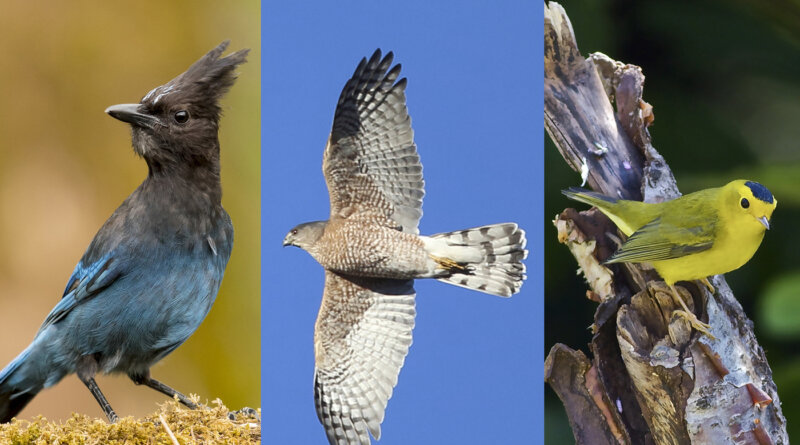Dozens of birds named after people are about to be renamed : NPR

The Steller’s jay, Cooper’s hawk, and Wilson’s warbler will all get renamed under a new plan to remove human names from U.S. and Canadian birds.
Mick Thompson, Tom Murray, Jerry McFarland/Flickr Creative Commons
hide caption
toggle caption
Mick Thompson, Tom Murray, Jerry McFarland/Flickr Creative Commons

The Steller’s jay, Cooper’s hawk, and Wilson’s warbler will all get renamed under a new plan to remove human names from U.S. and Canadian birds.
Mick Thompson, Tom Murray, Jerry McFarland/Flickr Creative Commons
Get ready to say goodbye to a lot of familiar bird names, like Anna’s Hummingbird, Gambel’s Quail, Lewis’s Woodpecker, Bewick’s Wren, Bullock’s Oriole, and more.
That’s because the American Ornithological Society has vowed to change the English names of all bird species currently named after people, along with any other bird names deemed offensive or exclusionary.
“Names have power and power can be for the good or it can be for the bad,” says Colleen Handel, the society’s president and a research wildlife biologist with the U.S. Geological Survey in Alaska. “We want these names to be powerful in a really good way.”
The move comes as part of a broader effort to diversify birding and make it more welcoming to people of all races and backgrounds.
“We’ve come to understand that there are certain names that have offensive or derogatory connotations that cause pain to people, and that it is important to change those, to remove those as barriers to their participation in the world of birds,” she says.
The project will begin next year and initially focus on 70 to 80 bird species that occur primarily in the United States and Canada. That’s about 6 or 7 percent of the total species in this geographic region.
The society has promised to engage the public, and says that birds’ scientific names won’t be changed as part of this initiative.
The effort represents a huge change for the birding community, and those involved expect a certain amount of opposition from long-time birders.
“I’ve been seeing some of these birds and using these names every year for the last 60 years,” says Kenn Kaufman, a prominent author of field guides. He says he initially opposed the idea of changing so many names, but has come around.
“It’s going to feel like a bother to some people, but I think it’s actually an exciting opportunity,” says Kaufman. “It’s an exciting opportunity to give these birds names that celebrate them — rather than some person in the past.”
While the society also has authority over English names of Latin American birds, it is planning a broader set of discussions with ornithologists and organizations in Latin America before proceeding with Latin American name changes.
“There are birds in South America that were named for friends of mine,” adds Kaufman. “I would like to think that they would accept this, for the benefit that it brings.”
The American Ornithological Society and its predecessor organization have maintained a list of the official English-language names for birds in North America since 1886. Occasionally, bird names have been changed, most often for scientific reasons.

This bird used to be named for Confederate General John McCown, but in 2020, it was renamed the Thick-billed Longspur.
Aaron Maizlish/flickr Creative Commons
hide caption
toggle caption
Aaron Maizlish/flickr Creative Commons

This bird used to be named for Confederate General John McCown, but in 2020, it was renamed the Thick-billed Longspur.
Aaron Maizlish/flickr Creative Commons
One notable exception came in 2000, however, when the society renamed a bird that’s now called the Long-tailed Duck because of concerns that its previous name was derogatory to Native Americans.
“That was the first that I’d ever really recognized or heard of a name that was offensive,” says Handel, who says at that point in time, concerns about injustice wasn’t a traditionally accepted reason for changing bird names.
That really started to change in 2020, when police officers killed George Floyd in Minneapolis. On that same day, a white woman in Central Park called the police on black birder Christian Cooper, claiming he was threatening her.
Less than a month later, a group called Bird Names for Birds wrote to the leadership of the society, pointing out the potential problems that come with eponymous honors and demanding change.
They noted that a 2019 proposal to rename a small prairie bird that had previously been named for Confederate General John P. McCown had been rejected.
In 2021, the society officially gave that bird the name “Thick-billed Longspur,” after amending its naming guidelines to explicitly consider social justice reasons, says Handel.
“Because of those associations with racism and slavery, it was decided that this name needed to be changed,” she explains.
Renaming a bird here and there was one thing. But the idea of renaming a whole slew of birds to remove names associated with historical figures? That took more mulling over.
“This proposal was so different because it was asking us to change an entire group of names instead of one by one,” says Handel.
A diverse group of ten experts met to consider it, says Erica Nol, a biologist at Trent University in Canada who co-chaired this ad hoc committee.
“The membership was carefully chosen to reflect broad perspectives. And it really did,” she says. “We all came to the decision in our own way and over time and quite slowly, actually, because the final decision is fairly radical.”
Kaufman, who was not involved in making the decision, says that initially, he thought that just a few really offensive bird names should be changed.
“I knew the young people who had started this Bird Names for Birds movement, and I tried to talk some sense into them,” he recalls. “But the longer we discussed this, the more I came around to seeing their viewpoint.”
Trying to do this bird by bird would mean engaging in divisive debates about individual people and the merits of whether or not they should have the honor of having a bird named after them, he realized.
“That just seemed like it would lead to endless arguments,” he says, adding that he didn’t think the birding community should become the morality police for people who lived two centuries ago.
Renaming the birds, in contrast, offered an opportunity to highlight unique features of the birds themselves. Unlike “Wilson’s warbler,” for example, the names “Yellow Warbler” or “Golden Winged Warbler” offer up a useful description, he says.
Take Brewer’s sparrow, says Kaufman.”What would be a good descriptive name for that? We can’t call it Sagebrush Sparrow, even though it is in the sagebrush,” he says, “because there is a sagebrush sparrow already.”
Nol says she recently was visiting some salt marshes this summer and saw a common bird there that’s called Wilson’s Snipe, which has a long bill and engages in dramatic displays such as flying in high circles, which produces a whistling sound as air flows over specialized feathers. “And I thought, what a terrible name,” she says. “I mean, Wilson was the father of modern ornithology in North America, but this bird has so many other evocative characteristics.”
She says people have pointed out to her that the birds don’t care what their names are.
“Names are important for humans. And this is absolutely a human-driven exercise,” she says. “They’re important for the people who watch birds and the communities who may or may not feel very welcome, if all the birds are named after these old European ornithologists.”







